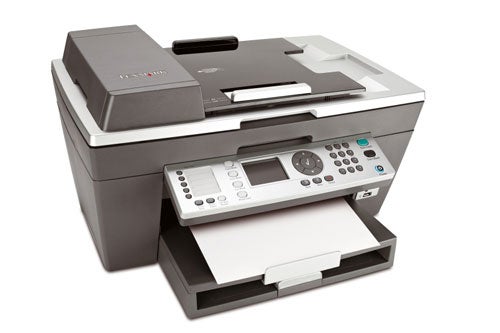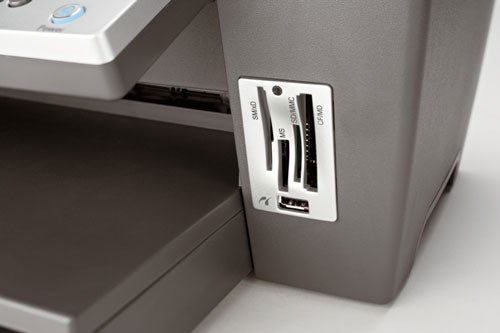Lexmark X8350 All-in-One Printer Review
Lexmark X8350 All-in-One Printer
Lexmark's X8350 all-in-one machine hits the spot with multiple functions and decent quality for less than £100.

Verdict
Key Specifications
- Review Price: £93.00
The X8350 is an inkjet-based, all-in-one business machine, sitting somewhere between Lexmark’s inexpensive home ink-jets and its high duty office lasers. Intended for small offices, it uses relatively low-capacity inkjet cartridges, but comes in at under £100 from Internet sources.
This is a very neat business machine, considering its scan and copy facilities include an automatic sheet feeder (ASF). It achieves this by using the design pioneered by HP, where paper is fed from a tray at the front and performs a 180 degree turn, before being printed on and ejected to another tray directly above the first.
Lexmark has aimed to cover all bases with the X8350. As well as the ASF, there’s a memory card reader for your digital photos, complete with an LCD display to preview them, and fax facilities.
The machine is controlled from a no-nonsense angled panel at the front and this includes quick-dial numbers for the fax, a number keypad and start buttons for mono and colour copies. The bright LCD panel is well used and the status information it provides is better organised than in many devices of the type.
Above the control panel is the hinged lid of the flatbed scanner, which has the ASF built into its lid. This is a compact little feeder, taking up very little extra height, though the design limits its capacity to 50 sheets. The print feed tray can take 100 sheets at a time, which is also a little low for a home office machine.
On the right-hand side of the front panel of the device is a card reader which handles all the common types, including xD and MicroDrive. There’s also a PictBridge socket for direct connection of cameras.
Lexmark provides a comprehensive suite of software to go with the X8350, including Presto! PageManager, Abbyy FineReader and the Lexmark Productivity Suite. These programs handle OCR for the scanner and photo manipulation of images uploaded from the memory card readers. There’s also a utility that can take scanned pages and turn them straight into PDF files, an invaluable aid for putting documents onto the Web or sending them as attachments.
The whole collection of applications installs without problem and is front-ended by the Lexmark Productivity Suite. There’s quite a bit of supplied software useful outside the strict confines of printing and scanning.
Print speed is never a particular strength of Lexmark machines, but our five page text document completed in 47 seconds, giving it a real-world print speed of over 6ppm. Colour print speed came out at just under 2ppm.
Lexmark is honest enough to quote speeds at normal print quality, as well as draft, though the values they claim, 13ppm and 5ppm, respectively, are still optimistic. We time tests from clicking Print in an application to the last page hitting the output tray in the printer and we suspect all printer companies time only the actual print time, without including rasterisation.
When we looked at the prints the X8350 produced, we saw pretty clear and dense black text print. There was a slight spattering around some characters, but no more than from similar, rival devices. Colour print of business graphics was better than this and we saw well filled areas of colour, with very little banding.
The photo print on Lexmark’s glossy photo paper using four ink colours was of very good quality, too, with clean, regularly varied sky and plenty of detail in shadowed areas. So much so, that we felt they should have been a bit darker.
We also copied the text and graphics page, using both the flatbed glass and the ASF. Results were generally good, though as usual, colours were less dense, with lighter tones in the original suffering the most. Even so, copies were acceptable and considerably cheaper than commercial printed ones.
The print engine takes two cartridges, black and tri-colour, and you can fit an optional photo cartridge for six-colour photo printing. The two main cartridges are available in standard and high yield versions and we used high yield cartridges to calculate costs. We produced around 440 pages from a black cartridge, though it’s hard to tell exactly when the black cartridge is spent, as the machine automatically switches to printing black with its tri-colour cartridge. The test result gives a 5 per cent black page print cost of 3.34p, which puts it in the middle of the ink-jet cost bracket.
The colour cartridge produced 587, 20 per cent colour pages, giving a cost per page of 24.3p. This again sits in the same range as most of the X8350’s competitors.
”’Verdict”’
The X8350 is a well-conceived all-in-one machine, ideal for anybody working from home or in a small office. Its dual abilities to send faxes and to print from memory cards, as well as the core print, scan and copy functions, make it a real all-rounder. Both print quality and running costs sit well up the range of what’s available and its asking price makes it very good value for money.
(table:ft)
(table:costs)
Trusted Score
Score in detail
-
Print Speed 7
-
Features 9
-
Value 10
-
Print Quality 8

